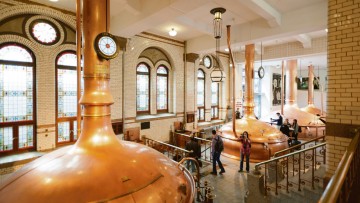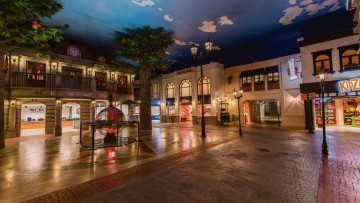Themed entertainment has moved out of the park. Once it was only the theme parks that offered immersive, active experiences, but now the skills and techniques of their designers and architects are being utilised by a growing number of other attractions. From zoos, aquariums and museums to factory tours and heritage sites, attractions are racing to turn interactive, investing in richly themed environments.
It’s easy to see why. Attractions are in competition with a huge array of leisure activities, from sports and shopping to increasingly sophisticated in-home entertainment and online gaming.
Visitors have high expectations and low boredom thresholds. They are also fully tech savvy so designers are adding cutting-edge mobile and digital technologies alongside complex themed design and architecture to put the attraction’s story across in the most compelling way.
From zoos, aquariums and museums to factory tours and heritage sites, attractions are racing to turn interactive, investing in richly themed environments
It’s all about visitors experiencing the attraction in a much more visceral way, connecting on an emotional level and creating an enduring relationship with the brand. Think of it as rollercoaster retail and emotional “edutainment”.
A powerful narrative
Back in 2009 Amsterdam’s The Heineken Experience netted around 350,000 visitors. By 2013 the figure had more than doubled. The reason was simple – a makeover by BRC Imagination Arts, a California-based design firm. BRC’s redevelopment was extensive, incorporating a strong story line and four floors of interactive exhibits alongside brewing artefacts, a tasting bar and even a ride.
“Success was not attributable to the technology used, but to the emotional connection forged through a powerful narrative,” says Dirk Lubbers, The Heineken Experience managing director.

Brewery at the Heineken Experience in Amsterdam
The Guinness Storehouse in Dublin, Ireland’s leading visitor attraction, also benefited from a BRC makeover. Once again, the aim was to “emotionalise” the visitor journey with a story-driven sensory experience augmented by multimedia technology. Interactivity is key. Guests not only learn how to pull the perfect pint, but get to share their experience on iPads. They can also leave a message on a digital wall. It’s proved a popular move, says Guinness Storehouse managing director Paul Carty, as more than 65,000 messages were left in the first 12 months.
Zoos are also transforming with a deepening emphasis on visitor engagement. Stacey Ludlum, a zoo designer with St. Louis-based PGAV Destinations, explains. “The goal of most modern zoo exhibits is to transport the guest to another time and place. It’s the romantic notion of sharing an experience with the animals. Barriers of some kind will always exist, but getting creative to minimise those barriers is the real innovation,” she says.
Chester Zoo’s £40-million Islands project, which opened in spring this year, is a good case in point. Designer Kieran Stanley of Berlin’s dan pearlman architects aimed to “turn the guests into explorers”. Visitors head off on an “expedition” across six South-East Asian islands. Rather than simply showcasing the wildlife, Islands reconstructs the daily life of naturalists in the field so visitors become part of the team, leaving with a feeling of ownership and a deeper understanding of the urgent need to protect fragile habitats.
Museums and galleries
Museums and galleries are turning digital as they seek to engage with the gaming generation. The British Museum and Tate have both turned to Minecraft, the multi-award-winning video game to help bring exhibits to life for a new, younger audience. Often described as “LEGO on steroids”, the game allows players to develop and build worlds within a virtual 3D environment using textured building blocks.
[embed_related]
Tony Guillan, multimedia producer at Tate Media, says: “It was clear from the massive popularity of the game and the amount of time young people spend playing it, that it has huge potential for engaging young people with the arts.”
So Tate launched a series of Minecraft “maps” inspired by artworks in their collection, using typical elements of Minecraft game play to allow users to explore the themes of the artworks. One map, based on Andre Derain’s 1906 painting, The Pool of London, focuses on Fauvist colours, incorporating an adventure around London where players search for pigments.
In contrast, the British Museum has enlisted the help of the game’s vast fan base to build a virtual copy of itself in the Minecraft world. Designed to help the museum engage with a wider audience, the aim is eventually to recreate its entire collection within the game.

Replica city at KidZania in Westfield London
The Victoria and Albert Museum has also incorporated gaming to bring exhibits to life. BAFTA-award-winning Sophia George, their first game designer in residence, created a game inspired by William Morris’ Strawberry Thief furnishing fabric. She says: “Smartphones, tablets and other digital devices are now a part of everyday life for a lot of people. So it makes sense that museums and galleries will take advantage of this technology.”
Waterparks
Gaming technology has even been incorporated into waterparks. The slideboard from Vancouver’s WhiteWater West is a high-tech “ride vehicle” that allows rider and slide to interact, creating a bespoke experience for the rider.
The growth of online shopping has created a headache for malls. To counter this, shopping centres are establishing themselves as leisure destinations, creating miniature theme parks inside their venues. This is “retailtainment”, a concept first identified by American sociologist George Ritzer.
“Entertainment has emerged as a guiding paradigm for shopping mall development,” says Yael Coifman, a partner at LDP, a London-based leisure consultancy. “The increasing availability of in-home entertainment and gaming make the more traditional forms of commercial entertainment in malls, for example bowling, less of a draw.”
Adding entertainment space has multiple benefits. Most mall visitors come from within a 30-minute drive, but adding good quality attractions can extend the catchment up to a two-hour drive time and encourage repeat visitors.
An example of retailtainment in action is KidZania London, which recently opened in Westfield Shopping Centre. With new locations opening worldwide, KidZania is a mini city where kids learn about the world of work through play. While their parents shop, children get to try out a variety of jobs – pilot, fireman, animator, chocolatier, radio host, mechanic – earning money in the form of kidZos to spend or save.
The days of dusty exhibits, dry facts and dull shopping trips are gone – theming is coming out of the park
The benefits of retailtainment are reciprocal. Being located in a mall, with a heavy existing footfall, represents a real opportunity for the attractions.
Waterparks have also seen the potential. For decades they have looked pretty similar – a collection of blue waterslides shining in the sun. Waterparks have certainly lagged behind theme parks in immersive theming and branding, but the industry has started to appreciate the need for more creativity in this field.
Cartoon Network Amazone is a notable trailblazer with richly themed slides and attractions from Polin. The waterpark opened a year ago in Thailand and characters from shows such as The Powerpuff Girls, Ben 10 and Adventure Time give an added dimension. “The Cartoon Network characters are equally as important as the water attractions,” says Liakat Dhanji, chairman of Amazon Falls, the owner of the park.
The move to tell stories that engage, create themed environments that resonate and utilise technologies that amaze will continue as mobile technology enables brands to understand their customers better, and create the individually tailored experiences we will come to expect. The days of dusty exhibits, dry facts and dull shopping trips are gone. Theming is coming out of the park.
A powerful narrative

Museums and galleries




